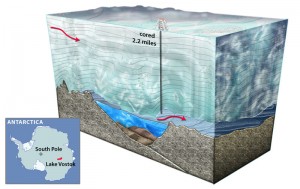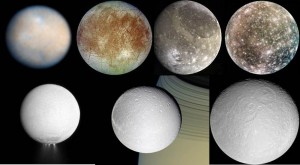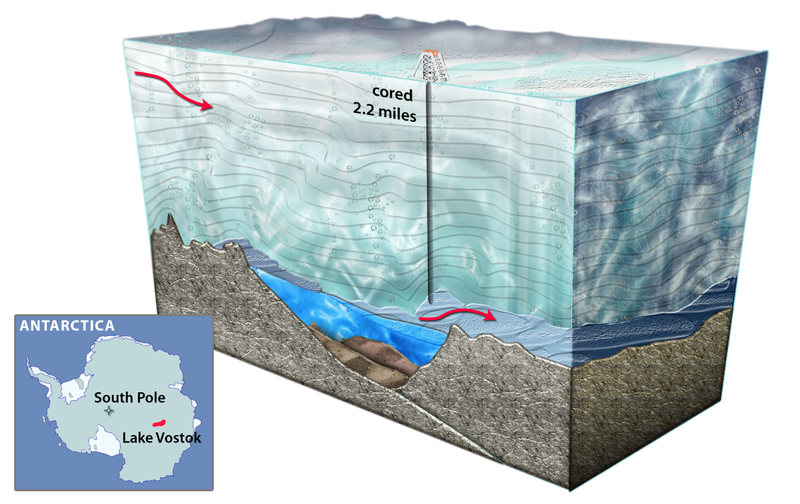Lake Vida lies under a thick ice cap in Antarctica and has been entombed for almost three thousand years. Yet even in this sub-glacial, ice-sealed lake there is life. The temperature of the water is -13 Celsius (8.6 Fahrenheit). The salinity, six times that of ocean water. Yet microbial life abounds, not to the extent that we see in surface freshwater lakes, but certain in sufficient quantity to be easily detected from samples brought up through drilled boreholes. The bacteria may be getting its energy from the saltwater because of its high salinity.
Russian, British and American scientists are drilling into other Antarctic sub-glacial lakes, the deepest being Lake Vostok, sitting under 3,770 meters (12,370 feet) of ice . Lake Vostok has been buried in ice for millions of years. When scientists begin sampling the lake water in December we will find out if even in this frozen under-ice world life exists. If so it may give us insight into the potential for life to exist off the planet on icy asteroids or several of the moons circling Jupiter and Saturn. Far from our traditional Goldilocks habitable zone models, cryo-ecosystems may exist in these frozen off-world environments. And exobiologists see a parallel exotic world in Antarctica’s sub-glacial lakes, a model that might very well be duplicated elsewhere in the Solar System.

A List of Likely Candidates for Cryo-Ecosystems
- Ceres – The largest asteroid in the Asteroid Belt is the next destination of the Dawn spacecraft. Ceres is believed to contain more freshwater than Earth (200 million cubic kilometers compared to 41 million for our planet). When Dawn arrives at Ceres in 2015 we will learn far more than we know presently which is that the asteroid’s surface exhibits the presence of water in clay hydrates and what appears to be seasonal polar ice caps.
- Europa – In November 2011 scientists reported that Jupiter’s moon Europa was not only an icy planet with an ocean of liquid water under a thick layer of ice, but had warm liquid water present in lakes 3 kilometers (about 2 miles) below its surface. Some of these lakes were comparable in volume to North America’s Great Lakes. Missions planned for Europa by NASA and ESA within the next decade should definitively provide us with a better understanding of the Moon’s capacity for supporting a cryo-ecosystem.
- Ganymede – JUICE, the Jupiter Icy Moon Explorer, with a planned launch for 2022, will study many of the moons of the Jovian planet including Europa, Callisto and Ganymede. Ganymede is larger than the planet Mercury and the largest moon in the Solar System. It has its own magnetic field and a tenuous atmosphere that contains oxygen. Ganymede’s surface is water ice almost 800 kilometers (approximately 500 miles) thick. The presence of atmospheric oxygen may be a result of sublimation and the breakdown of water molecules resulting from cosmic bombardment, or from subsurface liquid water being released periodically. This may occur from meteor strikes or from natural warming from within the moon itself. We’ll know more by 2030.
- Callisto – This Jovian moon is the third largest satellite in the Solar System with a mass slightly smaller than Mercury. It is heavily cratered but has no mountains. That’s because Callisto’s icy crust has plasticity and as it flows its smooths the surface. The ice crust is approximately 200 kilometers (124 miles) thick and the moon’s low density strongly suggests the existence of an ocean of water beneath.
- Enceladus – This 800 kilometer (500 miles) diameter moon of Saturn has surprised scientists right from the beginning when Cassini first photographed images of icy plumes containing water and organic matter rising from its surface. Too small to have a rocky core, Enceladus normal surface temperature is -198 Celsius (-324 Fahrenheit). But where the icy plumes are present temperatures are as high as -84 Celsius (-120 Fahrenheit). Enceladus is generating heat. Just how much? Equivalent to 2.6 times the amount coming from hot springs like Yellowstone. What scientists believe accounts for the icy plumes is an ocean of water beneath the moon’s surface. Could tidal forces explain the heat? Not according to scientists who estimate that tidal energy exerted on Enceladus equals about 1.1 gigawatts. Natural radioactivity scientists estimate adds 0.3 gigawatts. But Enceladus generates 15.8 gigawatts of energy making it an attractive candidate for a cryo-ecosystem.
- Dione – Not as small as Enceladus, Dione has a diameter of 1,123 kilometers (698 miles). It orbits about the same distance above Saturn as our Moon does above Earth. And like Ganymede, Dione’s tenuous atmosphere contains oxygen probably released from the ice that covers its surface.
- Rhea – Saturn’s second largest moon is 1,528 kilometers (949 miles) in diameter is 3/4 water ice and 1/4 rock. Like Dione its atmosphere contains oxygen probably originating from the decomposition of surface water molecules. But Cassini has found the presence of carbon dioxide as well. This may be caused by sublimation of trapped gases in the icy surface layer or by decomposition of deposits of carbon-rich materials from meteorite impacts. Of all the moons with potential to harbor cryo-ecosystems, Rhea is the most unlikely because it may not have liquid water under its icy crust. In fact, scientists describe Rhea as a “frozen dirty snowball.”











I don’t see any logical relationship between finding life in ice covered saline lakes in Antarctica and probabilities of finding organic life in the asteroids or Jovian moons. We can only speculate about processes that might have produced the life on Earth. We have no sound evidentiary basis to speculate how life might spontaneously arise on an asteroid or frozen moon (or for that matter anywhere else). (Within the next decade or so computer models might settle the question.) Part of our customary definitions of “life” is the notion that life must precede life. As far as we can tell all the life we know of was made by prior life. The begged question is, “ how does life travel from Earth, where we know it exists, to the moons and asteroids far up the solar gravity well and billions of miles distant?”
If we do find microbial life on the Jovian moons or asteroids, then it would seem likely life would exist in nearly all of the countless billions of planetary systems, and probably also in the Kuiper Belts and Oort clouds of all the stars. Panspermia would seem to be the most likely explanation. The phrase, “We are not alone,” takes on a vast new meaning.
Panspermia would be the most likely explanation for this speculation.